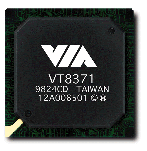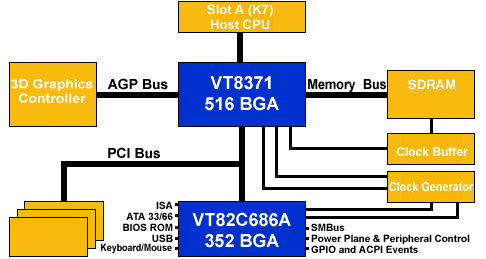New Hope For Athlon - The VIA Apollo KX133 Chipset
Introduction

AMD's Athlon-processor is a good and very well performing CPU. That's something we've learned in August 1999, when it was finally released and stole the performance crown from Intel. Many people were rather delighted that Intel finally got some really serious competition and so the Athlon made its claim to fame. Intel had quite a lot of trouble to keep up with this new AMD-processor, but finally the chip-giant was able to reclaim the lead with the rushed release of the Pentium 800, using the well-known 'Coppermine'-core.
A Little Quiz - Why Is Pentium III Faster Than Athlon?
The current status in the x86-processor scene shows Intel's Pentium III 800 (or 'CuMine800') as the leader and AMD's Athlon 800 as the number two, pretty close behind it. This 'I am number one and you are number two'-stuff is only something for the mentally not too challenged people though, since the whole story is a lot more complicated than some pure benchmark numbers comparing Athlon and Coppermine are able to reveal. The real secret lies in the 'platform-issue'.
The truth, if I may call it that, is that
- Pentium III 800 processors are very hard to get. Intel is able to produce some, but certainly not many of them.
- Pentium III 800 is currently only really fast on platforms that depend on the super-expensive RDRAM-memory. Using the i820 or better the i840 chipset with this RAM makes Coppermine really fly, but unfortunately there are very few people who are willing to pay the very high premium for this memory-type.
- many Pentium III 800-systems that are on sale are actually using VIA's Apollo Pro 133 chipset or i820 with the 'MTH decelerator chip'. Both types are using the much more reasonably priced SDRAM. The Apollo Pro 133 uses PC133 SDRAM, which gives the user at least some of Coppermine's performance, i820 plus the cursed MTH can only use PC100 SDRAM and slows even this memory down so badly, that the performance is rather mediocre.
- i810e may be an alternative for some people in Intel's management, but it's certainly one of the funkiest ideas to place a high-tech Coppermine-processor in a low-end i810e-motherboard. Would those Intel-managers once look at benchmark data of Pentium III on i810e vs. Athlon on Irongate they'd drop this idea pretty fast.
- other people are using the well-established, but 2-year old 440BX chipset. Those guys have mostly upgraded from a previous Pentium III-processor and are at least not wasting any money on memory or second-rate platforms. However, on BX-platforms Coppermine can only run at 100 MHz front side bus and it is also unable to take advantage of AGP4x. Thus the BX-solution besides VIA's Apollo Pro 133 is certainly the Coppermine-platform with the best price/performance ratio, but it still can't take full advantage of Intel's latest and greatest processor.
- AMD's Athlon is currently still damned to run on platforms using the one-and-only Athlon chipset 'Irongate', also manufactured by AMD. This chipset was initially still good enough to compete against all Intel processors on any platform, but it was already pretty outdated when it came to market. Today it is certainly not quite up to the latest standards anymore and we should therefore not be surprised that even the fastest Athlon can't beat Intel's fastest Pentium III processor, as long as it's slowed down by a second-rate chipset.
AMD's Struggle To Keep The Industry Interested
The main reason why it took so long until another Athlon-chipset came out is very easy to name. The reason is called 'AMD'. Before you get upset let me please explain why I say that:
- AMD may have a respectable market share in the x86-processor business and it's certainly the number two after Intel, but how far behind Intel is AMD? It's far enough behind that many companies can't be bothered to put any high emphasis on developments for an AMD-processor. Last year we could see that it was even worse. Taiwanese motherboard-makers couldn't be bothered to offer Athlon-platforms, even though AMD could have equipped each motherboard with a CPU. That was even at the time when AMD was the clear performance leader! AMD may like it or not, its name doesn't pull enough weight in comparison to Intel's.
- The organization and infrastructure of AMD is also not comparable to Intel's mighty empire. Until only recently, Intel stood for extremely high reliability in the business world. A company that worked together with Intel could look forward to fat profits and smooth operations. That might have changed with the i820-disaster and Intel's recent inability to ship desired product, but CEOs are still sleeping better (although maybe still not good enough) with Intel as a partner instead of AMD.
- AMD relied on 3rd -party chipset makers to come out with a new Athlon-chipset. Would Intel ever do that? Intel produces its own chipsets and until the i820-farce it used to have the reputation as the producer of the most advanced x86-chipsets on the market. We know that AMD does not have the resources to design a new Athlon-chipset, but what AMD tells you is that 'they don't want it '.
Now many of us are Athlon-fans, but we're still not stupid. An Intel-processor on a well performing and reasonably priced platform could still be more attractive than the beloved and excellent Athlon-processor on an outdated platform. The 'Irongate' is an outdated platform all-right, but AMD is currently really lucky that Intel is unable to supply a reasonably priced platform that performs well. Intel's i820 and i840 chipsets are expensive due to the RDRAM-issue and a Coppermine-processor in an i810e-board is such a ridiculous idea, that not even the most inexperienced customers would fall for it. Intel's new weapon will be i815 though and Athlon should get a new and modern platform before this chipset comes out.
The Release Of The Apollo KX133 - Better Late Than Never!
After endless delays, VIA has finally released the Apollo KX133 chipset. This chipset was initially supposed to be launched right after AMD released Athlon. Compared with Irongate the feature list is rather impressive.
- PC133 memory, offering 33% higher memory bandwidth
- AGP4x-support, to take advantage of the latest 3D-chips
- ATA66 to improve the performance of the latest hard drives
- Two USB-hubs, resulting in four USB-ports
- AC97 low-cost audio and MC-97 low-cost modem support
- 2 GB max memory support
So far so good. However, the bad Tom always finds something to complain about. First of all I am asking for SMP-support. The KX133 does still only support one processor, so dream on you Athlon-fans with desire for multi-processor systems. The next thing I need to criticize is AGP4x combined with PC133 memory bandwidth. KX133 offers a peak memory bandwidth of about 1 GB/s, AGP4x can transfer data from main memory to the video-memory at exactly the same bandwidth. This means that no 3D-card will ever be able to take full advantage of AGP4x on a KX133-platform, because the CPU or other DMA-using devices will always require some memory bandwidth at the same time. Again VIA puts us off for 'later'. At some time in the bright future there will be a successor of KX133 with DDR-SDRAM support, offering a peak memory-bandwidth of 2 GB/s. Let's hope VIA can pull that off as quickly as NVIDIA did it in case of their GeForce-cards. I am having my doubts though...
Stay on the Cutting Edge
Join the experts who read Tom's Hardware for the inside track on enthusiast PC tech news — and have for over 25 years. We'll send breaking news and in-depth reviews of CPUs, GPUs, AI, maker hardware and more straight to your inbox.
The Block Diagram Of Apollo KX133

Let's be honest, it looks like all other previous AGP-chipsets from VIA and most of Intel's too. There's a north and a south bridge, both are connected with the PCI bus, the memory and AGP are directly hooked up to the north bridge... We've seen it hundreds of times, each time in a different color though. The point that I am trying to make is that VIA doesn't have a funky 'hub-architecture' such as Intel's latest 810,820 and 840-chipsets.
Most Popular

